Table of contents:
Learning how to publish a podcast is easy once you know the process.
You’ve recorded your podcast, uploaded it to a host, and you’re ready to share it with the world, which means listing it in all the best directories. Spotify and Apple Podcasts are great places to start so we’ll show you step-by-step how to get your podcasts onto these platforms, as well as other favorites - Google Play Music, Stitcher, and TuneIn.
Read on for a full 7-step process to get your podcast to iTunes, Spotify, or any other directory.
What Is A Podcast Directory?
You may not have realized that podcasts aren’t actually stored on directories like Apple Podcasts or Spotify, they’re stored on your podcast host. Rather, a directory is like a phonebook - a place to find what you’re looking for. When someone plays a podcast on their chosen directory, it’s channeling audio that’s hosted somewhere else. Essentially, a directory does not store your podcast media files, it plays them from your host.
For podcasters, directories are a way to get yourself heard and receive new traffic. Some are more specialized, enabling you to tap into an audience that’s already engaged with your niche (e.g. a NASCAR directory). Others are expansive and cover any and every topic - the most popular directories tend to be like this, including Apple Podcasts and Spotify.
Additionally, your directory is a space where you can collect ratings and reviews from your listeners, to boost the legitimacy and reputation of your show. Once your show is listed on the major platforms like Apple, Google, Stitcher, and TuneIn, you’ll also be able to use a WordPress plugin, like PowerPress, to share your podcast on your website.
As a listener, directories are the easiest way to find podcasts, and most allow you to browse either alphabetically or by topic.
What Do I Need To Submit My Podcast?
If you choose the right podcast hosting service, like Buzzsprout or PodBean, you'll have fantastic integration with directories, meaning you can do it all from the dashboard of your host. Regardless, on the most basic level, you’ll need an mp3 file of your recording and an RSS feed for it, generated by your host. RSS feeds use a family of standard web formats to publish information that you can update with content and metadata, like episode titles, author names, and descriptions. Once you list your podcast, the directory will automatically pull every new episode in the future.
When it comes to more detailed specifications, different directories have different requirements for the other specificities. The industry standard, which includes Apple and Spotify, requires an RSS 2.0 conforming feed, a link to a square cover image (1:1) of at least 1400 x 1400 pixels, but not more than 3000 x 3000 pixels. Most importantly, the server holding your audio files (your host) must support byte-range requests, so that the files can be streamed.
Once you’ve submitted your podcast on your chosen directories like Apple and Spotify, you’ll also want to “claim” it so that you can receive valuable podcast analytics, including the number of listeners and downloads.
How do I publish my podcast online?
Once you've chosen a podcast hosting platform and directory, these are the general steps to publishing your podcast:
- Create a podcast RSS feed on your hosting platform.
- Submit the RSS feed to your podcast directory.
- Wait for your RSS feed to be approved.
- Publish and view your podcasts.
We know that the process changes depending on your podcast directory so we covered a few popular options in more detail below.
How Do I Get My Podcast Into iTunes or Spotify?
Apple Podcasts (Previously iTunes)
Having your podcast listed on the Apple Podcasts app is the ultimate way to tap into a loyal audience and garner respect and a positive reputation.
Before setting up your Apple podcast, here are some requirement:
- Firstly, you’ll need an RSS 2.0 conforming feed: Some hosting sites have a built-in validator for RSS feeds, so you can be sure there are no errors and you’re all good to go. If you built your own feed, use Podbase (Apple’s recommended podcast validator) to test it out and make sure it’s compliant.
- Have enough episodes ready: We recommend having at least 3 episodes before you submit to the Apple directory (if not, it is significantly less likely to feature you as noteworthy).
- Audio formats: Apple accepts both WAV and MP3 audio files and suggests a sampling rate of 44.1 kHz.
- Artwork requirements: JPEG or PNG files with 3000 x 3000 pixels. The images must not include explicit language, reference to illegal drugs, profanity or violence and they should be clear and sharp.
Step 1: Create a new Apple ID specifically for your podcast. Log into Podcast Connect.
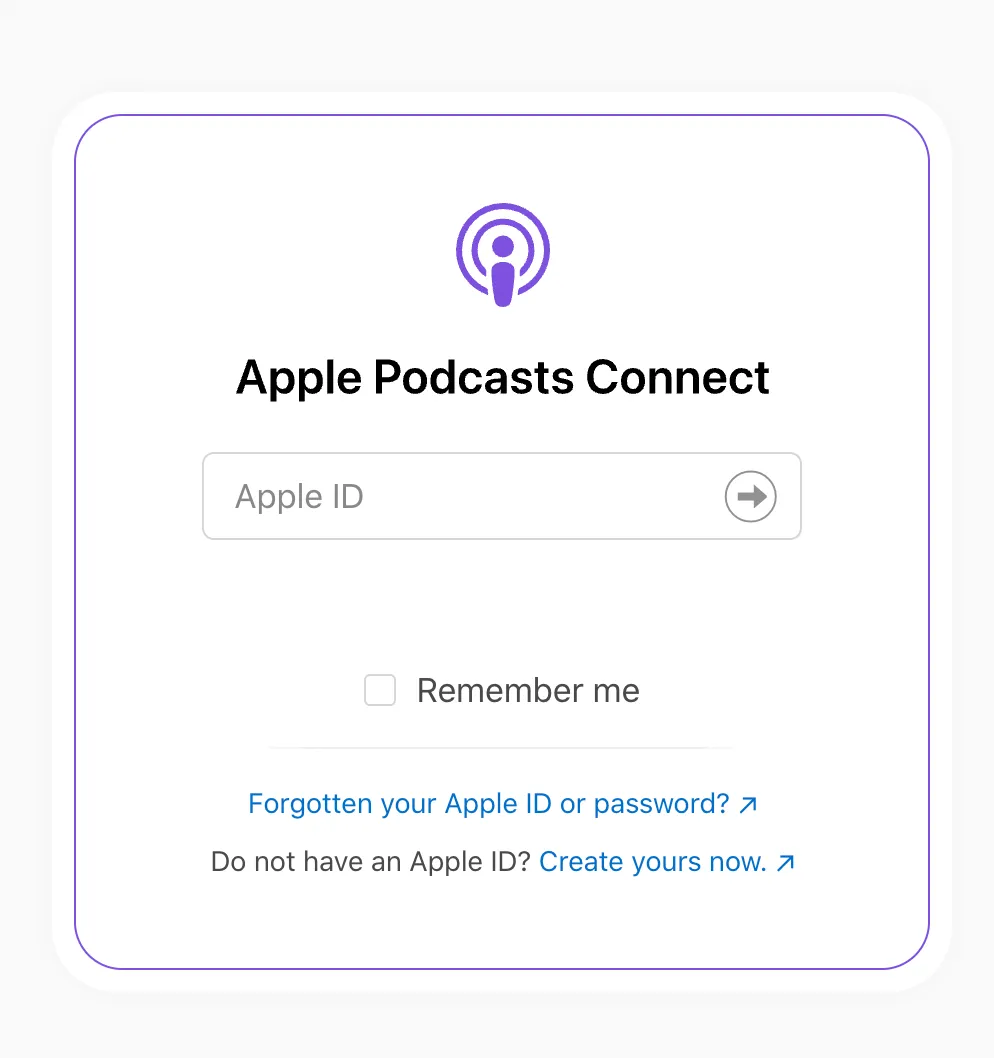
Step 2: Click on the + button to add your podcast show.
Step 3: Select Add a show with an RSS feed and press Next.
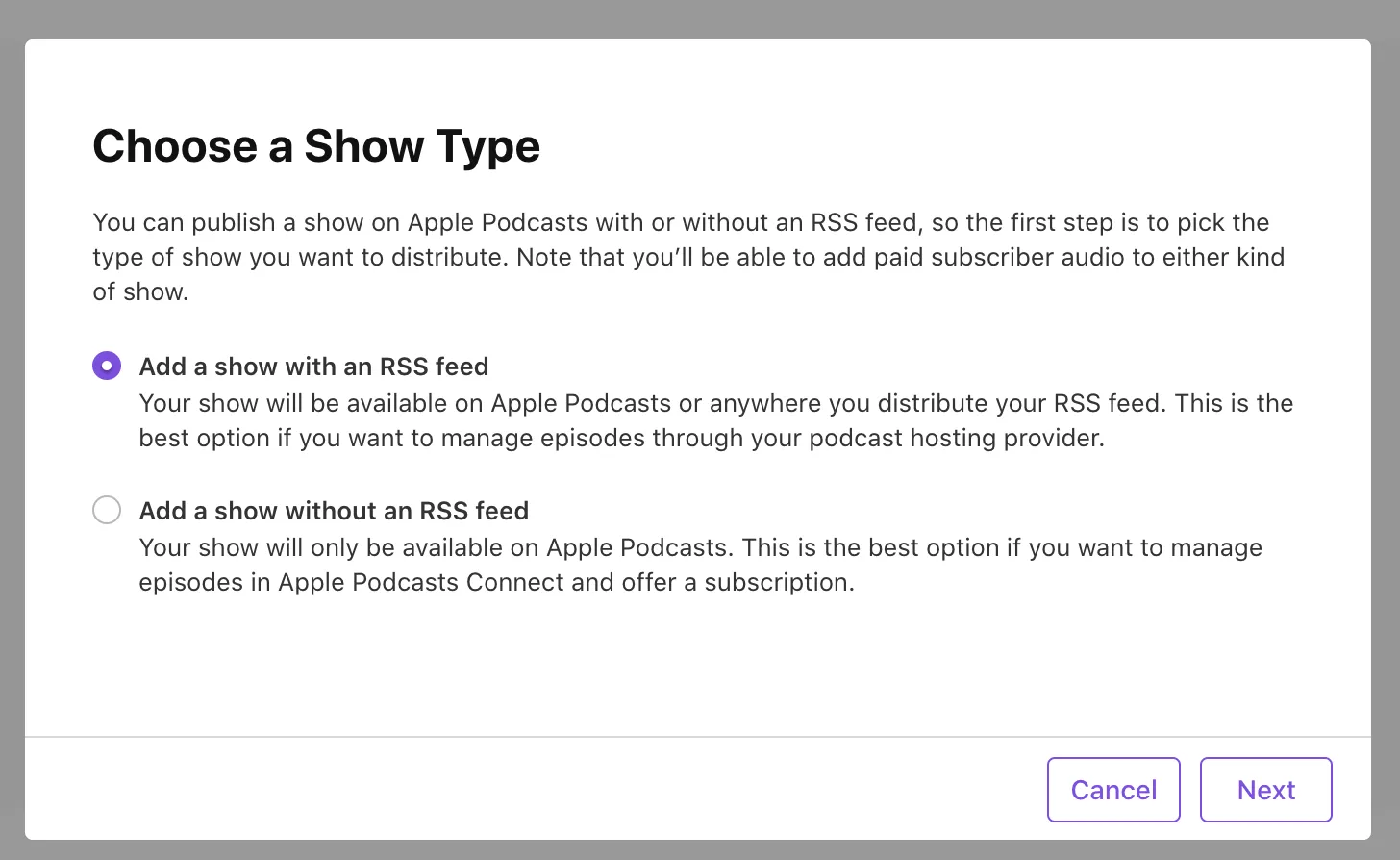
Step 4: This will take you to a simple page, with a box to paste your RSS URL.
Step 5: Click validate to check your URL. An error message will appear if there is a problem with the feed.
Step 6: Click submit.
Step 7: Once your feed has been validated, click the Submit button and wait for approval (anywhere from 24 hours to two weeks). Apple will email the address you entered as your iTunes email.
After Apple approves your show, it'll be available in the Podcast app on iOS and macOS devices.
Spotify
With over 150 million active subscribers, Spotify is definitely on par with Apple as one of the top podcast directories. While Apple has more podcast downloads, Spotify actually has more listeners and recently introduced video podcasts.
The requirements are as follows:
- Video Format: H.264 High profile, with a 16:9 layout and a bitrate of 25 Mbps for 1080p resolution, or 35 Mbps. The length can be a maximum of 12 hours.
- Audio Format: ISO/IEC 11172-3 MPEG-1 Part 3 (MP3) audio with a bitrate between 96kbps and 320kbps (aka MP3 with good audio quality).
- File Size: Episodes should be less than 200MB - that’s 83 mins at 320kbps or 200 mins 128kbps.
- Separate tracks: You must have separate audio and video tracks that are in sync with each other.
- Artwork: JPG or PNG with a square aspect ratio of 1:1 in the highest resolution available.
- Feed Values: Episode titles should not exceed 20 characters. Special characters, like !@£$%^&*() must be HTML encoded.
- Feed Fields: Your podcast must have a title, artwork, and at least 1 episode to be considered.
Spotify is a bit different when it comes to submitting your podcast. Instead of submitting your RSS feed as you do with the other directories, you need to go through your media host instead. A much easier way to do this, is to use Spotify's own distributing platform Anchor, now part of Spotify for Podcasters which automatically publishes your podcast to Spotify.
In order to publish a podcast to Spotify through Anchor and Spotify for Podcasters follow these steps:
Step 1: Go to the Spotify for Podcasters website and click on the 'log in' button. Select where your podcast is hosted. In this case select, 'Anchor by Spotify'.
Step 2: Sign up for an account or log in.
Step 3: If you have already recorded an episode, click on 'New episode' on the top right of your screen.
Step 4: You can 'select a file' or drag and drop your pre-recorded episode. Alternatively, to create and record an episode from scratch you can select 'Record or edit'.
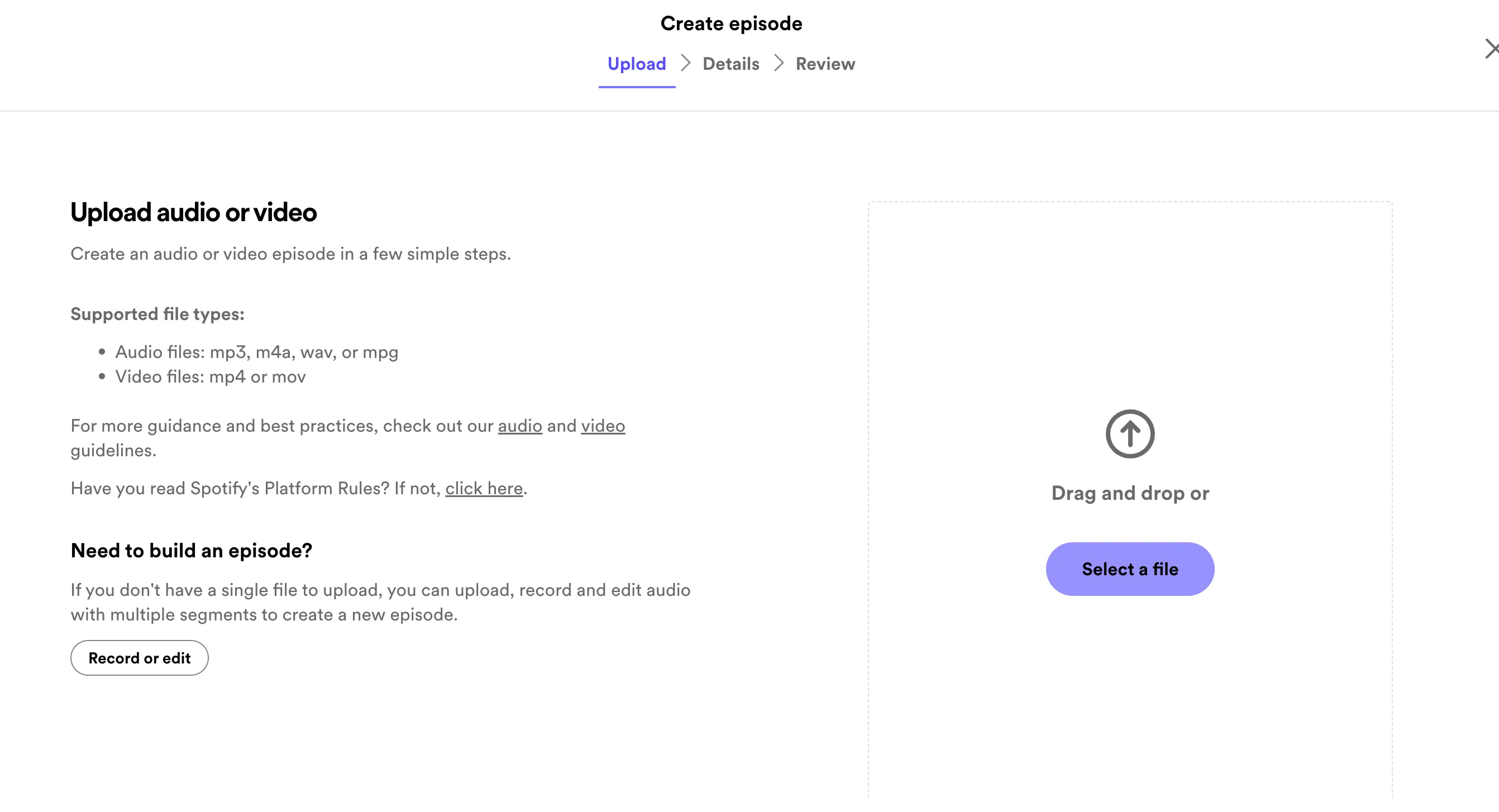
If you choose to record your episode directly on Spotify for Podcasters, you can record audio, add transitions and background music from Spotify's library. Note that this is only for recording audio. To record video, you can use Spotify's Riverside integration.

Step 5: After uploading your podcast, fill in all your episode details and when you're done select 'next'. Review your podcast and when you're ready you can publish.
Step 6: After you press publish, you must fill in your Podcast show details. You'll then click 'Continue' and a pop up will ask you to upload a podcast cover or create one.

It's actually super simple to make one with Spotify for Podcasters if you don't already have one. You can choose an image, and easily add text to include your title.
Step 7: Finally, you're ready to publish. Go ahead and 'publish' and your podcast should automatically appear on Spotify as well.
Spotify has also recently enabled video podcasts and has partnered with Riverside for the optimal way to produce video podcasts. You can now record in top-quality on Riverside, and directly share your video podcast to Spotify's millions of viewers.
In order to publish a podcast to Spotify with Riverside follow these steps:
Step 1: Open or create a Riverside recording studio and invite up to 7 guests.
Step 2: In the studio click the 'Record' button to start recording your podcast and press the stop button when you are done.
Step 3: After everything is uploaded, go to your video recording and select 'Go to editor' to start customizing and editing your podcast.
Step 4: When your podcast is all edited, click on 'Export' to prepare your video podcast for exporting. Riverside will send you an email with your recording file.
Step 5: Go to your Riverside email, and select 'Preview & Publish' to view your ready recording file.
Step 6: In the preview tab and click on the ‘Spotify button’ to publish your video podcast to Spotify. A pop up will appear asking you to head over to Anchor. Click 'Let's go' to continue.
Step 7: You'll be redirected to Spotify for Podcasters where you can log in or sign up, choose a podcast to export your video to and then fill in your episode's details.
Step 9: Press 'Publish now' once you're done and your video podcast will publish to Spotify and any other platforms linked to your Anchor account.
See for yourself how easy it is to publish a podcast on Spotify through Riverside. Start creating podcasts in high-quality today!
How To Upload Your Podcast To Any Other Directory
Luckily, many directories and podcast listening apps use Apple Podcasts as their source of data. So, once you’ve listed your show with Apple, it will automatically appear in other apps like Overcast, Castbox, and Pocket Casts.
Still, you’ll want to manually submit your feed to other popular podcast directories, most of which follow a similar process to Apple. Read on for a step by step guide to being listed in Google Play Music, Stitcher, and TuneIn.
Google Podcasts
Step 1: Create a Google or Google Apps Account, if you don’t already have one. Consider creating a shared account for your company, so that multiple people can add and manage podcasts. All podcast content needs to follow the Content and Conduct Policies for Podcasts on Google Play.
Step 2: Go to the Google Podcast Manager and click “Start Now”
Step 3: Enter your RSS feed URL- it must conform to the RSS 2.0 specifications and have all required tags. If you’ve already published a podcast to Apple Podcasts using an RSS feed, you can use many of the same tags when adding an RSS feed on Google Play Music.
.webp)
Step 4: N.B. Ensure your RSS feed has a valid
Step 6: Google will send you a verification code to the email associated with your RSS feed, which you enter in the box.
Step 7: Publish your podcast.
Step 8: Wait for approval. Your podcast could be rejected for a number of reasons, for example:
- Similar content - the title and author are too similar to a pre-existing podcast.
- Ownership - you can’t confirm ownership of the podcast.
- Content violations - podcast content or images violate the Terms of Service or Content Policies. For example, explicit content needs to be tagged accordingly in the RSS feeds to comply.
Once Google approves your podcast, it will be available on the native podcast app across android devices.
YouTube
YouTube is a little different to the other directories on this list, because it doesn't work with an RSS feed. Instead, YouTube podcasts are simply YouTube playlists where each video you add is an episode. That said, with over 2 billion users, YouTube is a great place to distribute your podcast.
To publish your podcast on YouTube, follow these steps:
Step 1: Go to your YouTube studio and click the ‘Create’ button, then select ‘New Podcast’
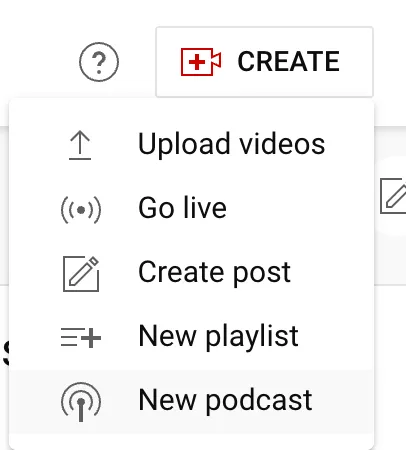
Step 2: A pop up menu will appear. You can choose to either ‘Create a new podcast’, or you can choose to ‘Set an existing playlist as a podcast’.
Step 3: If you create a new podcast, you’ll get a prompt to fill in the details of your Podcast show. Fill in your title, description and upload a cover. You can also choose if you want your podcast to be private or not. When you’re done select ‘Create’
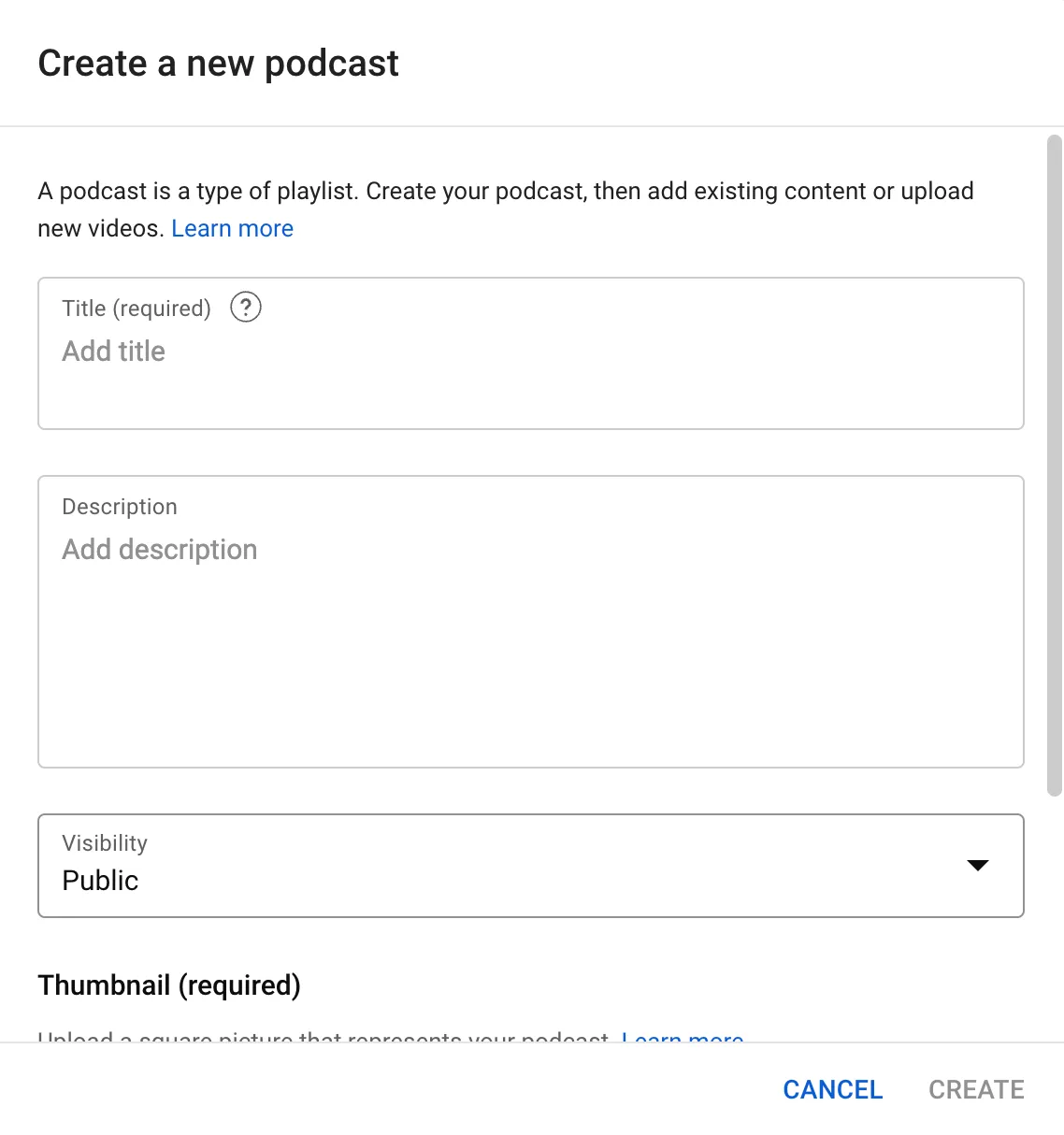
Step 4: You’ll now have a podcast playlist ready to go. Click on the ‘Add videos’ button to start adding new podcast episodes.

Step 5: Upload a new video, or choose an existing one and follow the prompts. If you’re uploading a new video, YouTube will ask you to fill in a title, description, thumbnail, and the usual settings of uploading a Youtube video.
If you’re choosing a pre-existing video, then simply choose which videos you’d like to add. YouTube will direct you to all your videos, and you can just click the check box next to your videos of choice.
Then click ‘Add to playlist’ and then select your podcast from the list, then click ‘Save’.
If you want to turn an existing playlist into a podcast follow these steps:
Step 1: Click the ‘Create’ button in your YouTubeStudio, then select ‘New Podcast’, and then ‘Set an existing playlist as a podcast’.
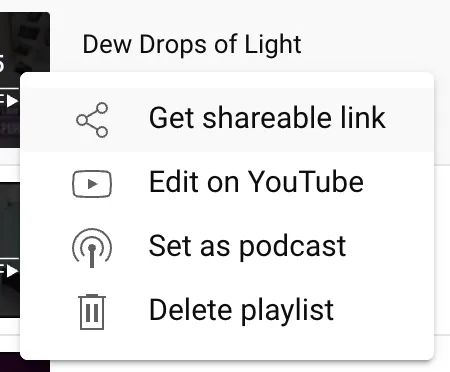
Step 2: YouTube will redirect you to your playlists. Select one and hover over it, to see a three-dotted vertical menu. Click on the menu, and then select ‘Set as podcast’.
Step 3: Just like above, you’ll need to fill in your podcast details including a title, description, and thumbnail. Click ‘Create’ when you’re ready to publish your show.
Simply as that, you have a full video podcast on YouTube.
TuneIn
TuneIn is a directory for free internet radio, sports, music, news talk, and podcasts.
Step 1: Fill in their podcast submission form.
Step 2: Your email address, Podcast Title, and RSS Feed URL are required.
Step 3: If you want to assign the podcast feed to an existing program listed in TuneIn, please explicitly write the program ID (ex. 'p123456') that you are adding the feed to in the 'Comment' field and they will update it accordingly.
Step 4: Click the checkbox next to “I accept and agree to the Terms & Conditions”. Click the Send Email button.

5. You will receive an email from TuneIn giving you the status of your submission.
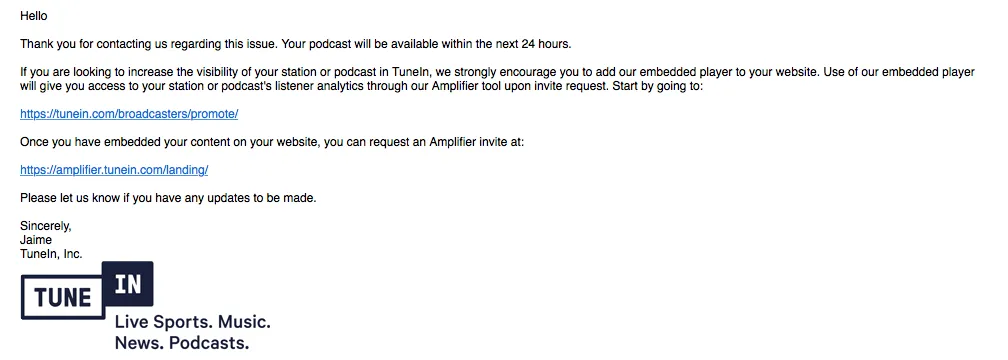
6. Your podcast will now be listed on TuneIn!
Amazon Music
Getting your podcast onto Amazon Music, is actually pretty simple.
Step 1: Go to Amazon Music for Podcasters
Step 2: Click on 'Add or Claim Your Podcast' then enter your RSS feed URL.

Step 3: Accept the terms of use and then wait for a verification email.
Step 4: Open your email, and 'Confirm Ownership'.
Just like that your podcast should link to Amazon Music.
How much does it cost to publish a podcast?
You can publish a podcast for free if you use a free plan on a hosting platform and podcast directory. Most podcast directories have free plans, although it could be worth paying a few dollars each month to get more benefits. Usually you'll pay around $10- $20 depending on the plans you choose.
Wrap Up
Bam! Just like that, your podcast is listed in the top directories in the world. Now, you can focus on creating valuable, engaging content for your listeners, and watch the numbers grow. As your podcast gains traction, you can build on the momentum by using effective marketing tools and using fun features like live-streams and live Q&As with your audience.
We suggest you start with Riverside, where you can easily produce professional podcasts at any level. Find out more here, or sign up to start recording!


.webp)












.webp)





